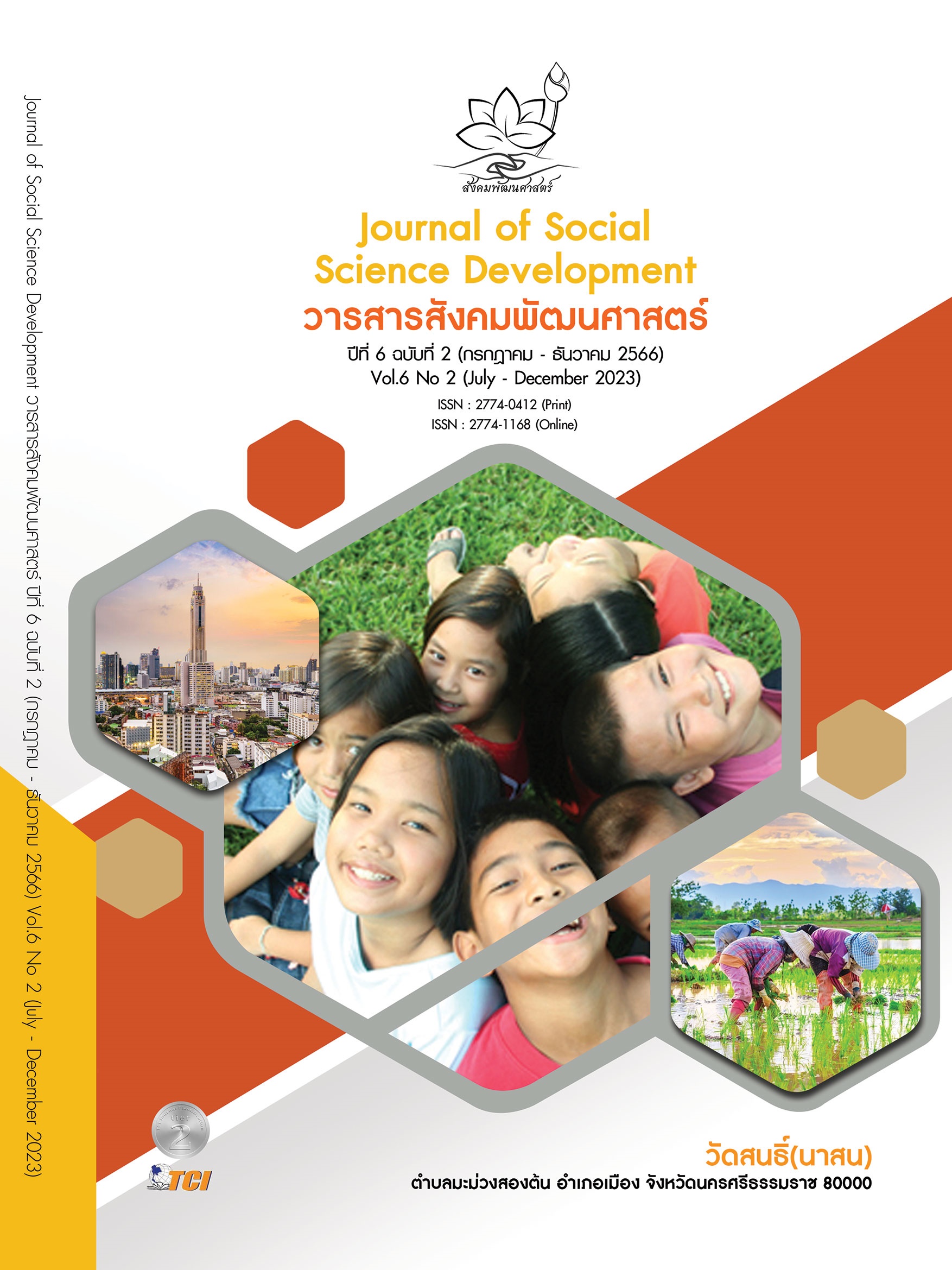รีไซเคิล : แนวทางการส่งเสริมการแปรรูปผลิตภัณฑ์จากวัสดุเหลือใช้ กรณีศึกษา ศูนย์เรียนรู้ และขับเคลื่อนปรัชญาของเศรษฐกิจพอเพียง หมู่ที่ 2 ตำบลถ้ำพรรณรา อำเภอถ้ำพรรณรา จังหวัดนครศรีธรรมราช
Main Article Content
บทคัดย่อ
บทความวิจัยครั้งนี้มีวัตถุประสงค์เพื่อ ศึกษาวิธีการแปรรูปผลิตภัณฑ์จากวัสดุเหลือใช้ สภาพปัญหาการแปรรูปผลิตภัณฑ์จากวัสดุเหลือใช้ และแนวทางการส่งเสริมการแปรรูปผลิตภัณฑ์จากวัสดุเหลือใช้ โดยใช้การวิจัยเชิงคุณภาพ ผู้ให้ข้อมูลสำคัญ ประกอบด้วย ผู้ให้ข้อมูลหลัก คือ กลุ่มแม่บ้านของศูนย์เรียนรู้และขับเคลื่อนปรัชญาของเศรษฐกิจพอเพียง หมู่ที่ 2 ตำบลถ้ำพรรณรา อำเภอถ้ำพรรณรา จังหวัดนครศรีธรรมราช จำนวน 8 คน ผู้ให้ข้อมูลรอง คือ ผู้ส่งเสริมและสนับสนุนแนวทางทางการส่งเสริมการแปรรูปผลิตภัณฑ์จากวัสดุเหลือใช้ จากศูนย์เรียนรู้และขับเคลื่อนปรัชญาของเศรษฐกิจพอเพียง หมู่ที่ 2 ตำบลถ้ำพรรณรา อำเภอถ้ำพรรณรา จังหวัดนครศรีธรรมราช จำนวน 9 คน ผลการวิจัย พบว่า 1) วิธีการแปรรูปผลิตภัณฑ์จากวัสดุเหลือใช้ พบว่า 1.1) การเลือกใช้วัสดุ ที่หาได้จากครัวเรือน เพื่อลดการทิ้งขยะในชุมชน 1.2) คำนึงถึงสิ่งแวดล้อมโดยการเลือกใช้วัสดุที่สามารถนำกลับมาใช้ใหม่ 1.3) ออกแบบผลิตภัณฑ์ให้สามารถสะดวก ต่อการการนำกลับมาใช้ใหม่ 1.4) ออกแบบให้ผลิตภัณฑ์มีความทนทานใช้งานได้นานขึ้น และ 1.5) สามารถปรับเปลี่ยนผลิตภัณฑ์หนึ่งไปเป็นผลิตภัณฑ์อีกอย่างหนึ่งได้ 2) สภาพปัญหาการแปรรูปผลิตภัณฑ์จากวัสดุเหลือใช้ พบว่า 2.1) สภาพปัญหาการบริหารจัดการผลิต 2.2) สภาพปัญหาการผลิตกระบวนการที่ทำให้เกิดมูลค่าเพิ่ม 2.3) สภาพปัญหาการจัดเตรียมวัสดุ และ 2.4) สภาพปัญหาการตลาด 3) แนวทางการส่งเสริมการแปรรูปผลิตภัณฑ์จากวัสดุเหลือใช้ พบว่า 3.1) แนวทางการส่งเสริมการผลิตที่ทำให้เกิดมูลค่าเพิ่ม โดยการใช้ความคิดเริ่ม 3.2) แนวทางแก้ปัญหาการสร้างแบรนด์ผลิตภัณฑ์จักสาน 3.3) แนวทางการวางแผนการเลือกวัสดุ และการบริหารความเสี่ยงในการผลิต และ 3.4) แนวทางแก้ปัญหาพัฒนาสื่อการตลาด
Article Details

อนุญาตภายใต้เงื่อนไข Creative Commons Attribution-NonCommercial-NoDerivatives 4.0 International License.
เอกสารอ้างอิง
กรณัท สุขสวัสดิ์. (2562). เพิ่มมูลค่าจากของเหลือทิ้ง สู่ ”กระดาษใบไผ่”. เรียกใช้เมื่อ 2 มกราคม 2567. จาก https://siamrath.co.th/n/114418
กุลนาถ ตันพาณิชรัตนกุล. (2553). การสร้างรูปแบบบรรจุภัณฑ์จากเศษไม้ยางพารา เพื่อส่งเสริมผลิตภัณฑ์ภาคใต้ กรณีศึกษาเรือกอและจำลองภาคใต้. กรุงเทพมหานคร: มหาวิทยาลัยศิลปากร.
ฐากร ถาวรโชติวงศ์. (2561). โครงการออกแบบผลงานสร้างสรรค์จากเศษวัสดุในหัตกรรมไทย. นครปฐม: มหาวิทยาลัยศิลปากร.
ปิยาภรณ์ คำยิ่งยง. (2558). การสร้างมูลค่าเพิ่มให้กับวัสดุเหลือใช้สู่ผลิตภัณฑ์ใหม่ที่เป็นมิตรกับสิ่งแวดล้อม. กรุงเทพมหานคร: มหาวิทยาลัยกรุงเทพ.
พอหทัย ซุ่มสั้นและคณะ. (2559). โครงการต้นแบบกลุ่มหมู่บ้านผลิตภัณฑ์จักสาน ตำบลท่าสาป อำเภอเมือง จังหวัดยะลา. ยะลา: คณะมนุษยศาสตร์และสังคมศาสตร์ มหาวิทยาลัยราชภัฏยะลา.
เมทิกา พ่วงแสง และหญิง มัทนัง. (2563). แนวทางการส่งเสริมการตลาดสำหรับกลุ่มวิสาหกิจชุมชนสตรีบ้านบึง ตำบลบ้านบึง อำเภอบ้านคา จังหวัดราชบุรี. วารสารปัญญาภิวัฒน์, 12(2), 55-66.
วาสนา เจริญวิเชียรฉาย. (2552). การออกแบบผลิตภัณฑ์ของตกแต่งบ้านจากวัสดุเหลือใช้. เรียกใช้เมื่อ 3 มกราคม 2567. จาก http://www.fa.rmutt.ac.th/wp-content/uploads/2011/07/การออกแบบผลิตภัณฑ์ของตกแต่งบ้านจากวัสดุเหลือใช้.pdf
วุฒิชัย วิถาทานัง. (2558). การพัฒนาเกณฑ์มาตรฐานผลิตภัณฑ์เครื่องจักสานเพื่อการส่งออก. วารสารวิจัยและพัฒนาวไลยอลงกรณ์ ในพระบรมราชูปถัมภ์, 10(2), 67-83.
ศรินทิพย์ ภัสดาวงศ์. (2548). ปัจจัยความสำเร็จในธุรกิจประเภทสินค้าของขวัญและของประดับตกแต่งบ้าน. ใน วิทยานิพนธ์ปริญญาเศรษฐศาสตรมหาบัณฑิต สาขาเศรษฐศาสตร์ธุรกิจ. มหาวิทยาลัยธรรมศาสตร์.
สาคร คันธโชติ. (2547). การออกแบบผลิตภัณฑ์งานไม้. กรุงเทพมหานคร: โอเดียนสโตร์.


